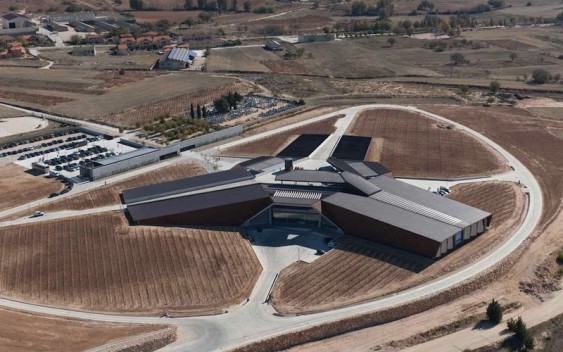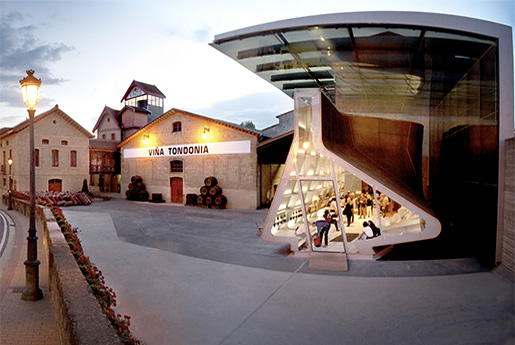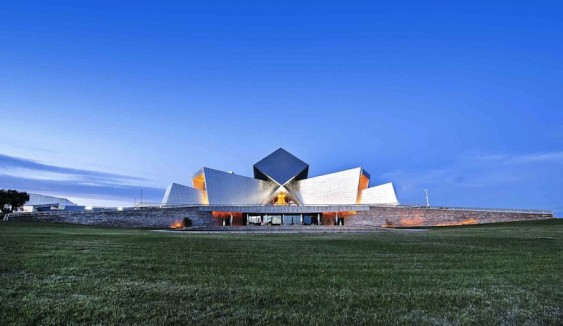If you ask me, the main reason to visit a winery is, of course, the wine! But that’s just the beginning these days, with many wineries offering everything from world-class art galleries to gourmet cooking classes to winemaking seminars in order to entice more visitors.
One of the most interesting trends I’ve gotten to see around the world in the past decade or so, however, has been the rise of architecturally significant wineries. While most wineries are primarily working facilities, and some of my favorite wines come from the ones with the fewest frills, there’s no doubt that wineries and avant-garde architecture go hand in hand. What might surprise you, however, is where some of the most interesting of these projects are being built.
You can find spectacular wineries in many countries – and I’ll cover them in future posts – but for this first installment, I thought I would talk about the country with one of the greatest concentrations of significant, recent winery developments: Spain.
If you plan to head there, it’s just a quick trip from Madrid to Rioja or Ribera del Duero to see some of these. Designed by world-famous architects, many are worth a visit for their structural merit alone (though the wines they make are pretty fantastic too!).

Bodegas Ysios was designed by Spanish starchitect Santiago Calatrava. Image source: La Rioja Enotourismo.
Bodegas Ysios
You might recognize Spanish architect Santiago Calatrava’s work from major structures including the Alamillo Bridge in Seville, the Milwaukee Art Museum’s Quadracci Pavilion and the forthcoming World Trade Center Transportation Hub in New York City. But he’s also the mind behind this stunning winery in Spain’s Rioja region. The winery opened back in 2001 and has since become a local landmark. Its undulating roof is meant to reflect the outline of the Cantabrian mountains in the distance while the slatted cedar walls pay homage to the barrel aging that is key to the making of Rioja wines.

Marques de Riscal’s sweeping building was designed by Frank Gehry. Photo source: Marques de Riscal.
Marqués de Riscal
Also in Rioja, near the medieval steeple-crowned town of El Ciego (and a fine counterpoint to it), this whimsical winery (and hotel, and Caudalie Spa and Michelin-starred restaurant) was opened in 2006. However, Marqués de Riscal itself has been around since the mid-19th century and its vineyards are among the oldest in Rioja. The firm commissioned it from world-famous architect Frank Gehry, and you’ll note a signature curvaceous titanium shell (like at the Bilbao Guggenheim Museum or LA’s Disney Concert Hall)…though this one has a ribbon of purple-pink to it that’s evocative of the tempranillo grapes growing on the surrounding vines.

Bodegas Portia is the brainchild of London firm Foster + Partners. Photo source: Foster + Partners.
Bodegas Portia
This ultra-contemporary construction in Ribera del Duero was designed by renowned London firm Foster + Partners, whose other notable projects include France’s Millau Viaduct, Berlin’s Reichstag redevelopment and the London’s St. Mary Axe Tower (fondly called “The Gherkin”). This one was built in 2010 and includes stark steel exterior walls and arrays of rooftop solar panels to help power the operations. Its three branches are meant to evoke the three major stages of winemaking: fermentation, aging and bottling. But not everything here is completely modern. The winery takes advantage of gravity – an old winemaking trick that minimizes both the handling of the grapes and the amount of power needed to process them – so that they are delivered and crushed on the roof and then fed into fermentation tanks below.

Iraqi-British architect Zaha Hadid conceived of Heredia’s new tasting room. Photo source: Lopez de Heredia.
López de Heredia
This is an old winemaking bodega (over 125 years, actually), but its current tasting and visitor pavilion only dates to 2006 and was designed by Pritzker Prize winner Zaha Hadid. You know, the woman behind London’s Aquatic Centre and Serpentine Sackler Gallery, Rome’s 21st Century Art Museum, and the forthcoming Japan National Stadium for the 2020 Olympics. The structure almost looks like a building within a building with a modular white metallic structure nestling into a larger glass façade. The overall effect is like finding a secret wine decanter (and tasting room!) hidden within a complex of century-old buildings.

Bodegas Sommos’s building is supposed to resemble a butterfly. Photo source: Bodegas Sommos.
Bodegas Sommos
This cubical winery in Spain’s Somontano region (in Aragon) opened in 2008 and has to be one of the country’s most visually stunning. It was designed by J. Marino Pascual and was supposedly inspired by a butterfly. Though the structure itself is amazing, most of it is actually underground, where the winemaking and aging takes place.

